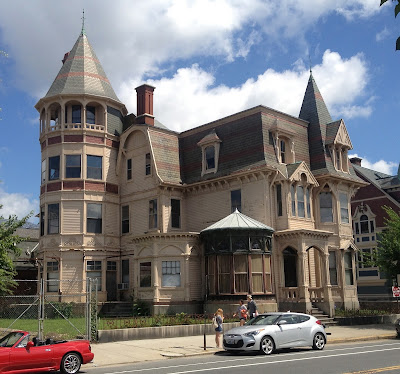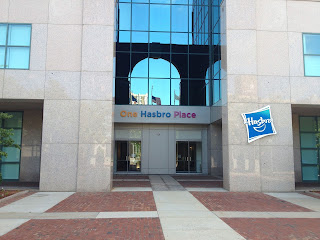Part 2 of "On Broadway" tells the story of an amazing house with a headline-grabbing murder associated with it.
The Owner: Jerothmul Barnaby
 |
| Jerothmul Bowers Barnaby |
The wonderfully-named Jerothmul Bowers Barnaby was born in Freetown, Massachusetts in 1830, to a family descended from early New England settlers. He moved to Providence at the age of 22 and started a clothing business, which he ran for 17 years. He married Josephine Reynolds in 1857 and they had three daughters: Mabel, Hattie, and Maud.
In 1869, Jerothmul opened a men's clothing store in downtown Providence under the name J. B. Barnaby & Co. It grew very quickly to become one of the largest stores in Rhode Island. A year after opening the store, he sucessfully ran for a seat on the Providence City Council, which he held for nine years.
The House: Barnaby's Castle
Barnaby's profits were apparently large enough for him to hire the prestigious local architectural firm of Stone, Carpenter, & Willson to build a showplace for him and his family in 1875.
Like the two 1867 houses in yesterday's post, this mansion is 2 1/2 stories in height with a mansard roof. The original 1875 house did not include the four-story 12-sided tower on the left, or the round conservatory towards the front of the house--these were added in 1885.
In Providence: A Citywide Survey of Historic Resources, the authors state that "the fanciful house is unique in Stone, Carpenter, & Willson's work and probably reflects more of the patron's exuberant taste than that of the firm's architectural attitudes. . . . It is visually both arresting and prominent, factors which make it perhaps the best known late 19th-century house in Providence."
 |
| Jerothmul B. Barnaby House, "Barnaby's Castle," 1875 and 1885 |
A year after the house was built, Barnaby mounted an unsuccessful run for Governor of Rhode Island, losing the election by only a few hundred votes. He next campaigned for a seat in the U.S. House of Representatives the following year, but also lost that election.
Barnaby retired from the clothing store business in 1889, and died the same year; his Boston Globe obituary carried the headline: "His attack of vertigo proves fatal."
The Murder
Something had happened to Josephine Barnaby in 1866 that caused partial paralysis; according to the New York Times, "her helplessness rendered her the prey of designing servants and other persons." Her husband was thus prompted to leave his estate in trust for his three daughters, giving Josephine only a $2,500 a year allowance.
Josephine immediately proved her husband's concerns correct by falling under the spell of a local physician by the name of Thomas Thatcher Graves. He told her that paralysis was one of his specialties, and she chose him as her personal physician and confidante. He persuaded her to contest her husband's will, and her daughters, wanting to avoid a trial and the negative publicity which would certainly accompany it, agreed to give her $120,000 in cash. (This was a sum they could clearly afford without difficulty, since their father had left an estate of almost $2 million.) Graves had the money paid to him as her agent (minus a fee for him and the lawyer who drew up the will), and he doled it out to her as he saw fit. He also persuaded her to leave him a healthy sum in her will.
Josephine spent the winter of 1890-91 in a California health resort with a friend, Mrs. Edward Worrell, presumably under the direction of Dr. Graves. At the end of their stay, she and Mrs. Worrell left separately but planned to meet up in Denver, where Mrs. Worrell's son lived. Josephine arrived in Denver on April 9th, and her friend informed her that a package had arrived for her which the Worrells were holding.
Inside the package was a wooden box which contained a bottle of whiskey, and the message "Wish you a happy New Year. Please accept this fine old whiskey from your friends in the woods." Two days later she and Mrs. Worrell decided to indulge in a "toddy" made from the whiskey, and both became violently ill--Josephine died a week or so later, on April 19th, 1891. The cause was poisoning from arsenic which had been added to the whiskey.
Dr. Graves was eventually arrested for the murder; apparently he had been concerned that Josephine might change her will. He was convicted in 1892, and sentenced to be hanged, but he won an appeal of the case based on the assertion that an incorrect instruction had been issued by the trial judge. He was in police custody, awaiting a new trial, when he committed suicide in 1893, bringing the whole sordid mess to a conclusion.
Mrs. Barnaby's murder was supposedly the first recorded murder in the US committed by mail! At least three books have been written about the case--the first one only a year or two after Josephine's death.
Postscript
The Barnaby clothing store in Providence had moved to a location at the corner of Westminster and Dorrance Streets in 1876, a year after the Castle was built. In the late 1890s, they took over a firm called Jerome Kennedy & Co., and adopted the Kennedy name for their business. (Perhaps Mrs. Barnaby's unsavory demise had something to do with that?) Kennedy's sold menswear in that location until 1978.
The beautiful home on Broadway has fallen on hard times in recent years. In 2011 and 2012, the Providence Preservation Society featured it in their "Ten Most Endangered Properties" list, since it was in a state of disrepair, and had stood vacant and neglected for years. Hopefully someone will preserve this fabulous structure before it's too late!
Update (November 10, 2016)

Reader "Don in Alabama" (see comments below) has sent along a photo of some sales receipts from the Barnaby clothing store in 1876. So cool to see these!
Illustration Credits and References
House photo by the author.
Other information from the work
Providence, A Citywide Survey of Historic Resources, by William McKenzie Woodward and Edward F. Sanderson, published by the RI Historical Preservation Commission in 1986, a blog called
Westminster Stories, a
New York Times article entitled "
Dr. Graves Convicted",
and a 1921 book edited by John D. Lawson: American State Trials: A Collection of the Important and Interesting Criminal Trials which Have Taken Place in the United States from the Beginning of Our Government to the Present Day, with Notes and Annotations, Volume 13 (Google eBook).












